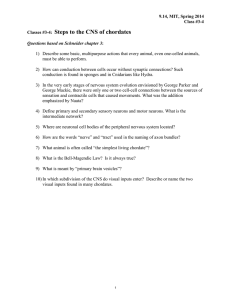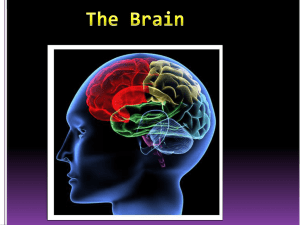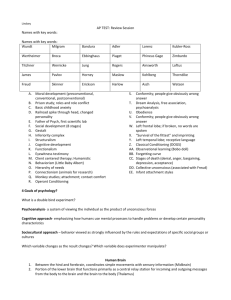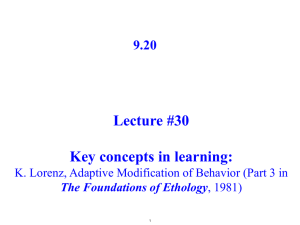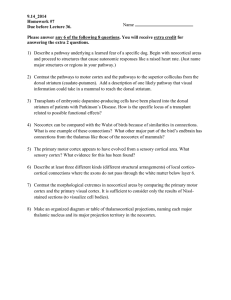Classes #5-6: Specializations in CNS evolution
advertisement
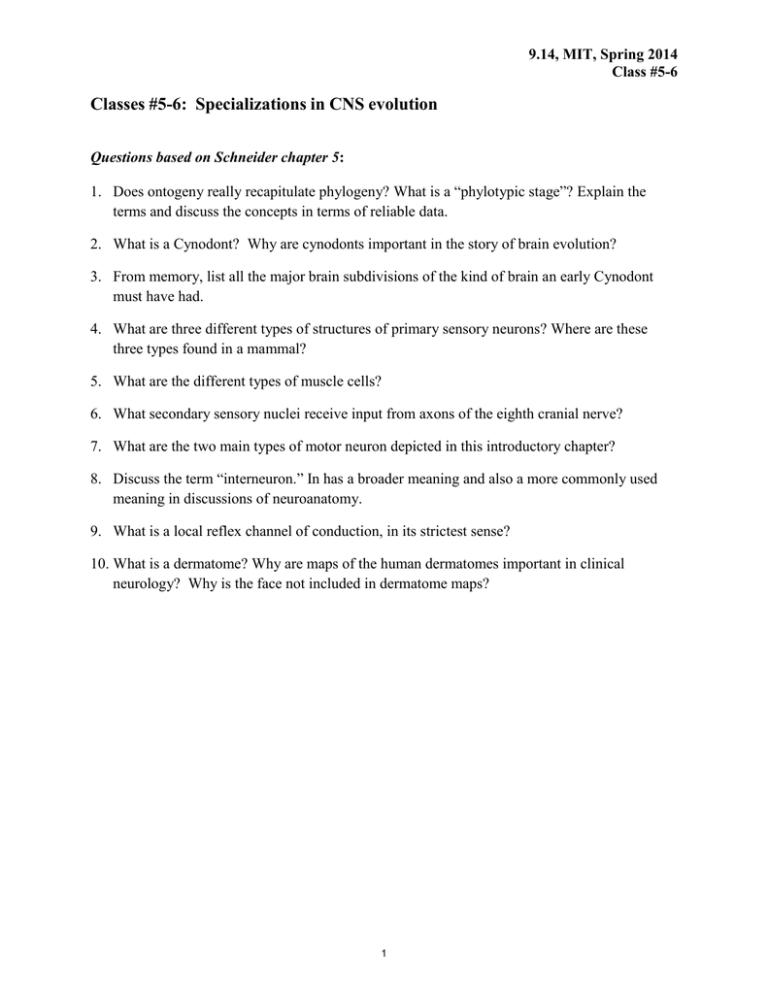
9.14, MIT, Spring 2014 Class #5-6 Classes #5-6: Specializations in CNS evolution Questions based on Schneider chapter 5: 1. Does ontogeny really recapitulate phylogeny? What is a “phylotypic stage”? Explain the terms and discuss the concepts in terms of reliable data. 2. What is a Cynodont? Why are cynodonts important in the story of brain evolution? 3. From memory, list all the major brain subdivisions of the kind of brain an early Cynodont must have had. 4. What are three different types of structures of primary sensory neurons? Where are these three types found in a mammal? 5. What are the different types of muscle cells? 6. What secondary sensory nuclei receive input from axons of the eighth cranial nerve? 7. What are the two main types of motor neuron depicted in this introductory chapter? 8. Discuss the term “interneuron.” In has a broader meaning and also a more commonly used meaning in discussions of neuroanatomy. 9. What is a local reflex channel of conduction, in its strictest sense? 10. What is a dermatome? Why are maps of the human dermatomes important in clinical neurology? Why is the face not included in dermatome maps? 1 9.14, MIT, Spring 2014 Class #5-6 11. What is the oldest ascending somatosensory pathway that reaches the brain? Contrast this pathway with another pathway that ascends from the spinal cord—a pathway that has often been called the “paleolemniscus” (the ancient ribbon)? 12. Describe the hypothesis presented in chapter 5 concerning why the cerebellum evolved. 13. It is generally true that the larger the cerebral hemispheres, the larger the cerebellum. However, there are a few species of animals without large cerebral hemispheres in which a greatly enlarged cerebellum is found. What are these animals? Questions based on Schneider chapter 6: 1. What cranial nerves carry information from electroreceptors in certain fish? Why is electroreception so useful for these fish? Why is their visual sense not adequate? 2. No placental mammals have electrosensory abilities, but one non-placental mammal does have such an ability. Which one? How are this animal’s electroreceptive inputs different from electrosensory fish in the cranial nerves involved? 3. Another sense that is not highly developed in mammals is infra-red detection. In what animals is this particularly important? Which cranial nerve is involved? 4. Bats are not the only mammal with echolocation ability. In what other mammal is it found? Which cranial nerve is greatly enlarged in that animal? 5. What is a brain manifestation of the specialization of primates for vision? 6. What is a brain manifestation of the specialization of small rodents for using their vibrissae (whiskers) so well? Describe other somatosensory specializations in some mammals/. 7. What may be a brain manifestation of the human abilities for complex social interactions? 8. What is a striking specialization (specific function unclear) in the brain of the Echidna (the spiny anteater of Australia)? 9. What other specializations might have noticeable brain manifestations? Try to think of something not mentioned in chapter 6. Questions based on Schneider chapter 7: 1. What is the major reason for the very different effects of forebrain removal in cats and rats? 2. Why was forced feeding required to keep decerebrate cats alive after the surgery? 3. Describe the behavior that shows how a cat without a forebrain shows no hunger motivation and yet will eat when food is placed in its mouth. 2 9.14, MIT, Spring 2014 Class #5-6 4. Is it true to say that the cat’s forebrain has “taken over” more functions than the rat’s forebrain? Is this the best way to describe the results of experiments? 5. What are some of the unlearned behavior patterns exhibited by pigeons that had suffered a disconnection of the forebrain from the midbrain, except for the connections from the eyes to the dorsal midbrain. 6. What is meant by “stability in time” and “stability in space”? In which of these is the forebrain most important? 7. What, in a simple phrase, is meant by diaschisis? Describe an example. Why is an understanding of this phenomenon so important in the interpretation of species differences in brain lesion effects? 8. What part of the forebrain is most involved in the changes that occur during habit formation, or procedural learning (implicit learning)? 9. According to the suggestions in this chapter, what is a reason why sensory pathways ascending to the forebrain almost always have a connection in the thalamus? 10. The limbic system is characterized by close interconnections with what portion of the upper brainstem? 11. Olfactory input dominated the ancient chordate endbrain, the predecessors of the limbic endbrain structures of mammals. This input was most likely important for two different types of learning, that later in evolution have come to depend just as much or more on inputs of other sensory modalities. Describe the two types of learning. 12. Within the endbrain of the first mammals or in their immediate predecessors, within the pallial structures, the neocortex evolved. With this evolution there was an expansion of a rapidly conducting pathway from the spinal cord carrying somatosensory information. It is sometimes called the neolemniscus. Describe or draw this pathway, indicating the location of the cell groups where synapses occur, and the location of a decussation. 13. With neocortex, there also evolved long descending connections from somatosensory areas, one of which evolved into the motor cortex. Describe or draw the pathway of corticospinal axons, indicating where it decussates. 14. What characterizes the sensory and motor functions of the neocortex? 15. In general, what other type of functions depend on the neocortex? Additional, supplementary questions: 3 9.14, MIT, Spring 2014 Class #5-6 1) The rostral-most motor neurons which innervate striated muscles are located in which brain subdivision? 2) What is spinal shock? Why is spinal shock an example of diaschisis? 3) Visual inputs are very primitive, and were a major influence on evolution of the forebrain. To which subdivision of the forebrain do these inputs connect? What is probably the most basic and widespread function of these inputs? 4) Modulation of functions of the entire organism are characteristic of one of the brain regions receiving optic input. To which region am I referring? 5) Why might most sensory pathways reaching the endbrain of mammals and other vertebrates synapse in the thalamus first? 6) The limbic system can be defined as a group of structures with close connections with what part of the CNS? What sensory pathway projects most directly to the limbic system? 7) Name two major long pathways associated with neocortex of present-day mammals, and describe their decussations. Questions on supplementary readings: Striedter 8) How does its location on a cladogram indicate that Amphioxus is a creature of special interest for studies of vertebrate evolution? 9) The axolotl has been particularly fascinating because of what ability? 10) What are “submammalian vertebrates”? Is this a proper term for reptiles or birds? 11) What major endbrain structure is lacking in marsupials? 12) The vertebrate brain “archtype” shown in Striedter’s figure 3.8 shows one region that is huge in teleosts but small, and usually not even named, in mammals. What is it? (This figure resembles the “premammalian brain” diagrams we use in the class.) 13) Why is it often easier to find similarities in embryonic brains than in the same adult brains? 14) What is a neuromere? [to be discussed in chapter 12] Questions on supplementary readings: Nauta and Feirtag, also Schneider 15) Give the English and the Greek terms for the primary brain vesicles. 16) What are the English equivalents for the terms “diencephalon” and “telencephalon”? 17) What are the attributes of a “cortex” in the brain? 4 MIT OpenCourseWare http://ocw.mit.edu 9.14 Brain Structure and Its Origins Spring 2014 For information about citing these materials or our Terms of Use, visit: http://ocw.mit.edu/terms.
